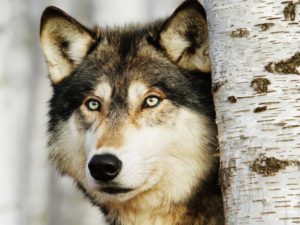By Ernie Stokely
 In spite of protests from neighboring ranchers, the grey wolf was reintroduced into Yellowstone Park in 1995. Elk and deer over-population and starvation had become a problem in the Park. Naturalists thought the presence of their natural predator might solve the herd starvation problems and bring the Park ecosystem into a more natural balance.
In spite of protests from neighboring ranchers, the grey wolf was reintroduced into Yellowstone Park in 1995. Elk and deer over-population and starvation had become a problem in the Park. Naturalists thought the presence of their natural predator might solve the herd starvation problems and bring the Park ecosystem into a more natural balance.
The cascade of events from the reintroduction of wolves into the Park has far exceeded even the wildest conjectures of Yellowstone ecologists. First noticed were the regrowth of willows around the creeks and the revival of shrinking groves of aspen where wintering herds of hungry elk had scraped away the snow to eat the tender shoots. Aspens, a plant that propagates through its root system, suffered and creek bank willows were depleted. The Park beaver population became stunted due to lack of winter food. Once the wolves returned, the beaver were able to again have a plentiful winter food source. Why? The elk herds were not only reduced, they avoided the open valleys around the creeks, allowing the willows to regenerate.
But, it was not just elk, beavers, and the aspens that felt the ripples of wolf reintroduction. Because of creek bank regrowth and the return of the normal beaver population, rivers literally changed course. Ponds were created, providing habitat for waterfowl, trout, and other aquatic creatures. Returning migratory birds found more nesting site choices, thanks to the wolves.
It was not just the trees, the beavers, the fish, the birds, and the healthier elk herds that are the beneficiary of the wolf reintroduction. Grizzly bears, eagles, coyotes, and other carrion eaters have flourished from the reestablishment of elk carrion, a regular menu item in the Park.
It’s not just the Yellowstone wolf story in that is opening our eyes to the interconnectedness of nature. We all know about the demise of the American honeybee and its impact on the pollination of our vegetable food sources. Beyond the importance that insects play in our lives, the story of interconnectedness turned to the recent biomedical discovery that the very fauna growing in our gut may play a dramatic role in our health. While we are just beginning to understand the full impact of these “bugs,” new discoveries suggest that the gut biome may play a major role in controlling weight, allergies, and even the regulation of our immune systems.
All this is to say, it’s time to be more aware of how completely interconnected life on the planet is. It is time to wonder about the unintended consequences of things like: the worldwide extinction of species, the local spraying of pesticides that may do little to kill mosquitoes but lays waste to most of our insect population, and the countless other human modifications of the planet ecosphere.


